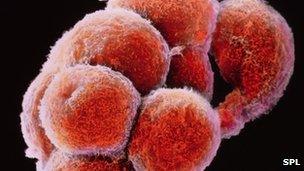IVF clinics told to cut multiple births to 10%
- Published

Implanting a single embryo carries less risk
IVF clinics have been told that no more than 10% of births should be twins or triplets by regulators.
The Human Fertilisation and Embryology Authority (HFEA) set the target in order to cut the number of multiple pregnancies from fertility treatment.
Such pregnancies carry significant risks to mother and babies, and a policy of single embryo transfer was introduced in January 2009.
The new rules come into effect in October this year.
Multiple-birth pregnancies have a higher chance of miscarriage, and of leading to premature birth and of babies with cerebral palsy.
Single embryo transfer (SET) is particularly recommended for women having IVF who are under 37, having their first cycle of treatment, and have "excellent quality" embryos.
Currently, clinics offering fertility treatment have a target of no more than 15%.
Embryologists say clinics are generally achieving that rate, or somewhere near it.
That is down from 23.6% at the beginning of 2008.
Best chance?
Writing to clinics to announce the latest change, external, Alan Doran, chief executive of the HFEA, said: "The sector as a whole has responded very well to the drive to reduce multiple births.
"Since the introduction of the policy in January 2009, the proportion of single embryo transfers has increased, the multiple pregnancy rate has decreased and the overall pregnancy rate has remained steady."
He said pregnancy rates from planned SETs were similar to those from double embryo transfers.
Rachel Cutting, chairman of the Association of Clinical Embryologists, welcomed the announcement.
She said: "The problem most clinicians have is when patients are paying for a cycle, it is hard to convince them to have just one embryo put back, because they automatically think two will give them a better chance.
"But HFEA figures show a tiny difference in pregnancy chances, but still an excellent chance of pregnancy."
Ms Cutting said it would be easier to meet the HFEA target if the NHS funded three cycles of IVF per couple, as recommended by the National Institute of health and Clinical Excellence (NICE).
- Published13 May 2011
- Published5 July 2011